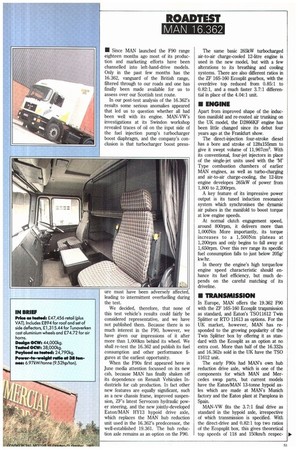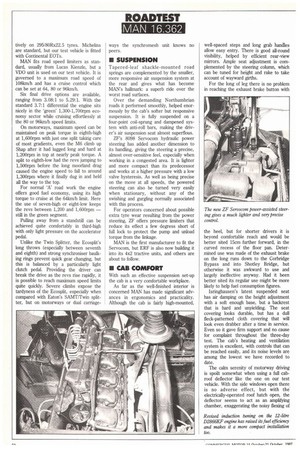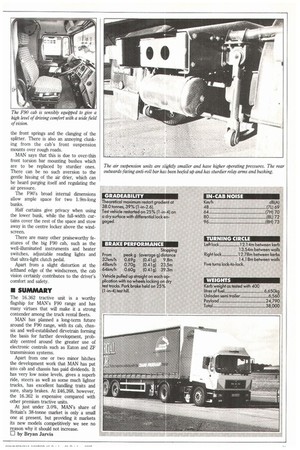• Since MAN launched the F90 range eighteen months ago
Page 53

Page 54

Page 55

If you've noticed an error in this article please click here to report it so we can fix it.
most of its production and marketing efforts have been channelled into left-hand-drive models. Only in the past few months has the 16.362, vanguard of the British range, filtered through to our roads and one has finally been made available for us to assess over our Scottish test route.
In our post-test analysis of the 16.362's results some serious anomalies appeared that led us to question whether all had been well with its engine. MAN-VW's investigations at its Swindon workshop revealed traces of oil on the input side of the fuel injection pump's turbocharger boost diaphragm, and the company's conclusion is that turbocharger boost press ure must have been adversely affected leading to intermittent overfuelling ,during the test.
We decided, therefore, that none of this test vehicle's results could fairly be considered representative, and we have not published them. Because there is so much interest in the F90, however, we have given our impressions of it after more than 1,000km behind its wheel. We shall re-test the 16.362 and publish its fuel consumption and other performance figures at the earliest opportunity.
When the F90s first appeared here in June media attention focussed on its new cab, because MAN has finally shaken off its dependence on Renault Vehicules Industriels for cab production. In fact other new features are equally significant, such as a new chassis frame, improved suspension, ZF's latest Servocom hydraulic power steering, and the new jointly-developed Eaton/MAN I-IY13 hypoid drive axle, which replaces the MAN hub reduction unit used in the 16.362's predecessor, the well-established 19.361. The hub reduction axle remains as an option on the F90. The same basic 265kW turbocharged air-to-air charge-cooled 12-litre engine is used in the new model, but with a few alterations to its breathing and cooling systems. There are also different ratios in the ZF 165-160 Ecosplit gearbox, with the overdrive top reduced from 0.85:1 to 0.82:1, and a much faster 3.7:1 differential in place of the 4.04:1 unit.
• ENGINE
Apart from improved shape of the induction manifold and re-routed air trunking on the UK model, the D2866KF engine has been little changed since its debut four years ago at the Frankfurt show.
The direct-injection four-stroke diesel has a bore and stroke of 128x155mm to give it swept volume of 11,967cm3. With its conventional, four-jet injectors in place of the single-jet units used with the 14' Type combustion chambers of earlier MAN engines, as well as turbo-charging and air-to-air charge-cooling, the 12-litre engine developes 265kW of power from 1,800 to 2,200rpm.
A key feature of its impressive power output is its tuned induction resonance system which synchronises the dynamic air pulses in the manifold to boost torque at low engine speeds.
At normal clutch engagement speed, around 800rpm, it delivers more than 1,000Nm More importantly, its torque increases to a 1,500Nm plateau at 1,200rpm and only begins to fall away at 1,650rpm. Over this rev range its specific fuel consumption falls to just below 205g/ kw/hr.
In theory the engine's high torque/low engine speed characteristic should enhance its fuel efficiency, but much depends on the careful matching of its driveline.
• TRANSMISSION
In Europe, MAN offers the 19.362 F90 with the ZF 168-160 Ecosplit transmission as standard, and Eaton's TS011612 Twin Splitter or RTO 11613 as options. For the UK market, however, MAN has responded to the growing popularity of the Twin Splitter box by offering it as standard with the Ecosplit as an option at no extra cost. More than half of the 16.332s and 16.362s sold in the UK have the TS0 11612 unit.
The early F90s had MAN's own hub reduction drive axle, which is one of the components for which MAN and Mercedes swap parts, but current models have the Eaton/MAN 13-tonne hypoid axles which are made at MAN's Munich factory and the Eaton plant at Pamplona in Spain.
MAN-VW fits the 3.7:1 final drive as standard in the hypoid axle, irrespective of which transmission is specified. With the direct-drive and 0.82:1 top two ratios of the Ecopsplit box, this gives theoretical top speeds of 118 and 1501cm/h respec tively on 295/80Rx22.5 tyres. Michelins are standard, but our test vehicle is fitted with Continental EOTs.
MAN fits road speed limiters as standard, usually from Lucas Kienzle, but a VDO unit is used on our test vehicle. It is governed to a maximum road speed of 108km/h and has a cruise control which can be set at 64, 80 or 96km/h.
Six final drive options are available, ranging from 3.08:1 to 5.29:1. With the standard 3.7:1 differential the engine sits nicely in the 'green' 1,300-1,7001-pm economy sector while cruising effortlessly at the 80 or 96km/h speed limits.
On motorways, maximum speed can be maintained on peak torque in eighth-high at 1,600rpm with just one split taking care of most gradients, even the M6 climb up Shap after it had lugged long and hard at 1,200rpm in top at nearly peak torque. A split to eighth-low had the revs jumping to 1,500rpm before the long moorland drag caused the engine speed to fall to around 1,300rpm where it finally dug in and held all the way to the top.
For normal 'A' road work the engine offers good fuel economy, using its high torque to cruise at the 641ErnAi limit. Here the use of seven-high or eight-low keeps the revs between 1,200 and 1,600rpm — still in the green segment.
Pulling away from a standstill can be achieved quite comfortably in third-high with only light pressure on the accelerator pedal.
Unlikethe Twin Splitter, the Ecosplit's long throws (especially between seventh and eighth) and strong synchroniser baulking rings prevent quick gear changing, but this is balanced by a particularly light clutch pedal. Providing the driver can break the drive as the revs rise rapidly, it is possible to reach maximum speed limits quite quickly. Severe climbs expose the tardyness of the Ecosplit, espeiially when compared with Eaton's SAMT/Twin splitter, but on motorways or dual carriage ways the synchromesh unit knows no peers.
• SUSPENSION
Tapered-leaf shackle-mounted road springs are complemented by the smaller, more responsive air suspension system at the rear and gives what has become MAN's hallmark: a superb ride over the worst road surfaces.
Over the demanding Northumbrian roads it performed smoothly, helped enormously by the cab's softer but responsive suspension. It is fully suspended on a four-point coil-sprung and dampened system with anti-roll bars, making the driver's air suspension seat almost superflous.
ZF's 8098 Servocom hydraulic power steering has added another dimension to its handling, giving the steering a precise, almost over-sensitive feel, especially when working in a congested area. It is lighter and more compact than its predecessor and works at a higher pressure with a low valve hysteresis. As well as being precise on the move at all speeds, the powered steering can also be turned very easily when stationary, without any of the swishing and gurgling normally associated with this process.
For operators concerned about possible extra tyre wear resulting from the power steering, ZF offers pressure limiters that reduce its effect a few degress short of full lock to protect the pump and unload torque from the linkage.
MAN is the first manufacturer to fit the Servocom, but ERF is also now building it into its 4x2 tractive units, and others are about to follow.
• CAB COMFORT
With such an effective suspension set-up the cab is a very comfortable workplace.
As far as the well-finished interior is concerned MAN has made significant advances in ergonomics and practicality. Although the cab is fairly high-mounted, well-spaced steps and long grab handles allow easy entry. There is good all-round visibility, helped by efficient rear-view mirrors. Ample seat adjustment is complemented by the steering column, which can be tuned for height and rake to take account of wayward girths.
For the long of leg there is no problem in reaching the exhaust brake button with the heel, but for shorter drivers it is beyond comfortable reach and would be better sited 15cm further forward, in the curved recess of the floor pan. Determined use was made of the exhaust brake on the long runs down to the Corbridge Bypass and into Shotley Bridge, but otherwise it was awkward to use and largely ineffective anyway. Had it been better sited its regular use might be more likely to help fuel consumption figures.
Isringhausen's latest suspended seat has air damping on the height adjustment with a soft enough base, but a backrest that is hard and unyielding. The seat covering looks durable, but has a dull fleck-patterned cloth covering that will look even drabber after a time in service. Even so it gave firm support and no cause for complaint throughout the three-day test. The cab's heating and ventilation system is excellent, with controls that can be reached easily, and its noise levels are among the lowest we have recorded to date.
The calm serenity of motorway driving is spoilt somewhat when using a full cabroof deflector like the one on our test vehicle. With the side windows open there is no adverse effect, but with the electrically-operated roof hatch open, the deflector seems to act as an amplifying chamber, exaggerating the noisy flexing of the front springs and the clanging of the splitter. There is also an annoying clunking from the cab's front suspension mounts over rough roads.
MAN says that this is due to over-thin front torsion bar mounting bushes which are to be replaced by sturdier ones. There can be no such aversion to the gentle hissing of the air drier, which can be heard purging itself and regulating the air pressure.
The F90's broad internal dimensions allow ample space for two 1.9m-long bunks.
Half curtains give privacy when using the lower bunk, while the full-width curtains cover the rest of the space and stow away in the centre locker above the windscreen.
There are many other praiseworthy features of the big F90 cab, such as the well-illuminated instruments and heater switches, adjustable reading lights and that ultra-light clutch pedal.
Apart from a slight distortion at the lefthand edge of the windscreen, the cab vision certainly contributes to the driver's comfort and safety.
• SUMMARY
The 16.362 tractive unit is a worthy flagship for MAN's F90 range and has many virtues that will make it a strong contender among the truck rental fleets.
MAN has planned a long-term future around the F90 range, with its cab, chassis and well-established dirvetrain forming the basis for further development, probably centred around the greater use of electronic controls such as Eaton and ZF transmission systems.
Apart from one or two minor hitches the development work that MAN has put into cab and chassis has paid dividends. It has very low noise levels, gives a superb ride, steers as well as some much lighter trucks, has excellent handling traits and sure, sharp brakes. At 246,268. however, the 16.362 is expensive compared with other premium tractive units.
At just under 3.0%, MAN's share of Britain's 38-tonne market is only a small one at present, but providing it markets its new models competitively we see no reason why it should not increase.
by Bryan Jarvis




































































































